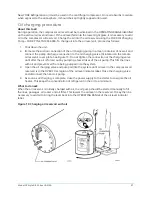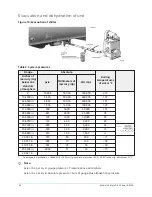
Acid cleaning of tubes
If the tubes are fouled with a hard scale deposit, they may require acid cleaning. It is important
that before acid cleaning, the tubes be cleaned by the brushing process first. If the relatively loose
foreign material is removed before the acid cleaning, the acid solution has less material to dissolve
and flush from the tubes, resulting in a more satisfactory cleaning job and a probable saving of
time.
WARNING
Acid cleaning should only be performed by an expert. Consult your local water treatment
representative for assistance in removing scale buildup and preventative maintenance programs to
eliminate future problems.
In many major cities, commercial organizations now offer a specialized service of acid cleaning
evaporators and condensers. Consider using this type of company if acid cleaning is required. The
Dow Industries Service Division of the Dow Chemical Company, Tulsa, Oklahoma, with branches in
principal cities is one of the most reliable of these companies.
Testing for evaporator and condenser tube leaks
About this task:
Evaporator and condenser tube leaks in R-134a systems may result in refrigerant leaking into the
water circuit, or water leaking into the shell depending on the pressure levels. If refrigerant is
leaking into the water, it can be detected at the liquid head vents after a period of shutdown. If
water is leaking into the refrigerant, system capacity and efficiency will drop off sharply. If a tube
is leaking and water has entered the system, the evaporator and condenser should be valved off
from the rest of the water circuit and drained immediately to prevent severe rusting and corrosion.
The refrigerant system should then be drained and purged with dry nitrogen to prevent severe
rusting and corrosion. If a tube leak is indicated, the exact location of the leak can be determined
by completing the following steps:
1. Remove the heads and listen at each section of tubes for a hissing sound that would indicate
gas leakage. This assists in locating the section of tubes to be further investigated. If the
probable location of the leaky tubes has been determined, treat that section in the following
manner (if the location is not definite, all the tubes will require investigation).
2. Wash off both tube heads and the ends of all tubes with water.
Note:
Do not use carbon tetrachloride for this purpose since its fumes give the same
flame discoloration that the refrigerant does.
3. With nitrogen or dry air, blow out the tubes to clear them of traces of refrigerant laden
moisture from the circulation water. As soon as the tubes are clear, drive a cork into each
end of the tube. Pressurize the dry system with 50 psig to 100 psig (345 kPa to 690 kPa) of
nitrogen. Repeat this with all of the other tubes in the suspected section or, if necessary, with
all the tubes in the evaporator or condenser. Allow the evaporator or condenser to remain
corked up to 12 to 24 hours before proceeding. Depending upon the amount of leakage,
the corks may blow from the end of a tube, indicating the location of the leakage. If not, it is
necessary to make a very thorough test with the leak detector.
39
Model YK Style G R-134a or R-513A






































